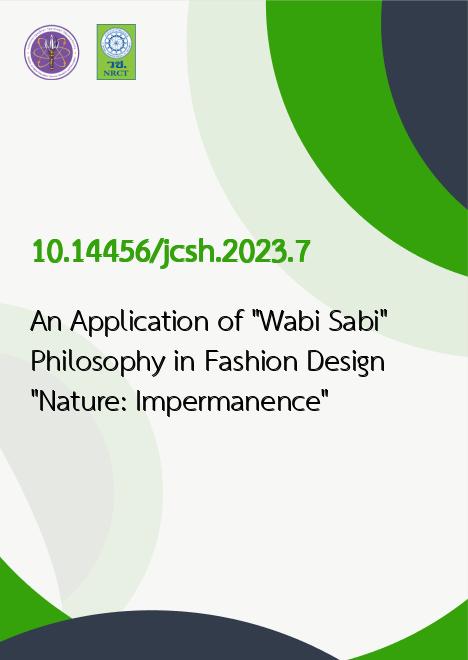
|
An Application of “Wabi Sabi” Philosophy in Fashion Design “Nature: Impermanence” |
|---|---|
| รหัสดีโอไอ | |
| Creator | Supreeya Suthamtarikul |
| Title | An Application of “Wabi Sabi” Philosophy in Fashion Design “Nature: Impermanence” |
| Publisher | Rangsit University |
| Publication Year | 2566 |
| Journal Title | Journal of Contemporary Social Sciences and Humanities |
| Journal Vol. | 10 |
| Journal No. | 1 |
| Page no. | 79-90 |
| Keyword | Wabi-Sabi, High Fashion, Impermanence, Simplicity, Symbolism |
| URL Website | https://jcsh.rsu.ac.th |
| ISSN | 2985-0541 |
| Abstract | This research aimed at studying and analyzing the “Wabi-Sabi” philosophy. Its root was in Buddhism, which has an important saying that "Everything in the world is vain" or impermanent, including the absence of a self or the feeling of emptiness. The “Impermanence” was used for the subject of this research. The other concepts were found which related to the “impermanence”. The evidence of discovered aesthetics was derived from literature, poetry, and tea ceremonies, as well as architecture including art techniques that involved the use of symbolism. The information obtained from the study was used to create high fashion designs. The final purpose is to design 5 high fashion apparels as follows.The “Impermanent” concept was interpreted from nature. It was used for story-telling along with other concepts such as simplicity which were used for main looks. As stated in the history of aesthetics, nature represented asymmetrical, unfinished, and incomplete things. All of them were incorporated to use in the creation. In addition, “Contradictions of thoughts” and “Emergence” that come from the history of aesthetics provide some conclusion. “Shibusa” or “Nature”, "Confusion", "Simplicity” were used in the creation of the apparels as well. Considering the apparels’ design, the simplicity or minimal look was applied by using “Kiri” a technique through the design method of cutting out unnecessary things to a minimum in “Wabi” appreciation. The purpose of “Iki” (new style with subtle sex appreciation in Edo period) was to apply the “Emergence” concept. In this collection, hand-woven fabrics with natural color were used together with fabrics dyed with natural colors, such as indigo and ebony. They represented “Wabi-Sabi” just as Rikyu's teacup concept which was simple and homegrown. The important “Symbolism” found in Heian period was used for design practice in this research. Research feedback from two focus groups; the first group, focused on an overview of suitable production which natural fiber handwoven fabrics were used in haute couture design. Cotton fabrics was seen too heavy. In addition, hemp and linin fabrics were too easy to crumble. Especially, pineapple fibers because they are too short, it was not suitable to be spun by hand. Moreover, hand weaving was seen as not tight enough and made the shape unstable. Therefore, the selected handwoven fabrics are seen moderately suitable. The overall looks were good. The second focus group focused on research and creative design which was seen good to very good. The outcome would be used to be a prototype in product development in the village in Lampang Province, Thailand. |